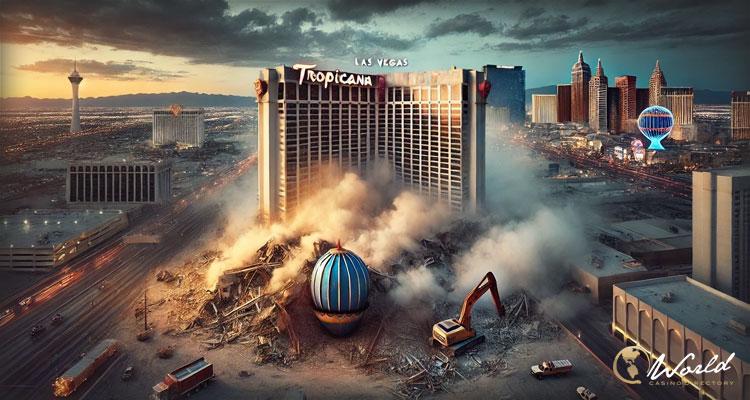The legendary Tropicana Las Vegas, once a beacon of glamour and opulence, has officially closed its doors after 67 years on the iconic Las Vegas Strip. This storied casino, with a rich history that intertwined with mob dealings and A-list celebrities, held its final moments in front of tearful employees and curious onlookers. The closure paves the way for the future—a $1.5 billion Major League Baseball stadium set to redefine the area as a hub for sports entertainment.
In its heyday, the Tropicana was a haunt for the famous Rat Pack and a location immortalized in films like the 1971 James Bond classic Diamonds are Forever, where Sean Connery’s Bond noted, “I hear that the Hotel Tropicana is quite comfortable.” But the golden era of mobster glamour and Rat Pack cool has given way to a new Vegas—a Vegas where sports reign supreme.
A Landmark Steeped in History
First opening its doors in 1957, the Tropicana was one of the oldest casinos on the Las Vegas Strip. At the time of its debut, Clark County’s population had just surpassed 100,000, and the Las Vegas landscape was mostly desert. Costing $15 million to build, according to the Associated Press, the Tropicana stood out with its well-kept lawns, a towering tulip-shaped fountain, and opulent mosaic-tiled interiors. It was known as the “Tiffany of the Strip,” a nickname that underscored its sophistication and beauty.
Over the years, the casino attracted some of the biggest names in entertainment. The likes of Frank Sinatra, Elizabeth Taylor, and Sammy Davis Jr. graced its halls, while the showroom saw performances by musical legends like Mel Tormé and Eddie Fisher. It became a symbol of Las Vegas luxury and entertainment.
One of the casino’s final guests, New Jersey native Joe Zappulla, spent $600 for the chance to stay in the iconic venue before it closed for good. His nostalgia was palpable as he reflected on his parents’ visits to the Tropicana in the 1960s. “Old Vegas, it’s going,” Zappulla remarked, tears streaming down his face. “I’m really clinging to a little piece of that.”
A Place of Mob Ties and Glittering Celebrities
Despite its glamorous façade, the Tropicana was not immune to the influences of organized crime. Mobster Frank Costello was notably linked to the casino’s operations in its early days. Costello’s near-fatal shooting in New York, weeks after the Tropicana opened, led investigators to uncover “skimmed” gambling profits, revealing the underbelly of Vegas’ mob connections.
By the 1970s, federal authorities charged multiple individuals with conspiring to skim millions from Las Vegas casinos, including the Tropicana. While mob influence eventually faded, the Tropicana continued to thrive, cementing its place in Las Vegas lore. The casino became the long-time home of the famous Folies Bergere show, a topless revue that defined the classic Las Vegas showgirl image for nearly 50 years.
Transformations Through the Years
Like many of its contemporaries, the Tropicana evolved with the times. The 1980s saw a rebranding of the casino as “the Island of Las Vegas,” complete with a swim-up blackjack table at the pool—a novelty that briefly captured the spirit of the times. In 2011, the casino underwent a South Beach-themed renovation to modernize its offerings and compete with the megaresorts springing up around it.
Yet despite the changes, remnants of the Tropicana’s original charm remained. Visitors like Las Vegas resident JT Seumala felt the nostalgia as they wandered through the low-ceilinged halls beneath the iconic stained glass ceiling. “It does feel like you step back in time for a moment,” Seumala reflected. But as the years went on, the casino’s influence waned. While still drawing in tourists, the Tropicana became dwarfed by the towering megaresorts that now define the Strip, including neighboring behemoths like the MGM Grand and Caesars Palace.
A Bittersweet Farewell
For employees like bartender Charlie Granado, who had worked at the casino for 38 years, the closure was a bittersweet moment. “It’s time. It’s ran its course,” Granado said. “It makes me sad. But on the other hand, it’s a happy ending.” On its last day, employees gathered at the main entrance, some shedding tears while others cheered as they shared final goodbyes with guests. Just before 1 p.m., the casino’s grand doors were chained shut, marking the end of an era.
On Wednesday morning, more than 2,000 pounds of explosives were used to put the iconic building to the ground. A video of the implosion was published by the Las Vegas Review-Journal, capturing the impressive moment when the history-filled building made way for an even brighter future for the Las Vegas Strip.
The closure of the Tropicana marks a significant turning point in Las Vegas’ ongoing transformation. The site is slated for demolition in October, making way for a new $1.5 billion ballpark that will house the Las Vegas Athletics, a relocation of the Major League Baseball team from Oakland.
Scheduled to open in 2028, the ballpark will seat 33,000 fans, representing Las Vegas’ continued shift towards becoming a hub for major sports franchises. The NFL’s Las Vegas Raiders, who left Oakland in 2020, and the NHL’s Vegas Golden Knights have already made their mark on the city. Now, with the arrival of Major League Baseball, Las Vegas will solidify its place as a premier sports destination.
The planned ballpark will occupy 9 acres of the Tropicana’s former 35-acre site. Bally’s Corp., which owns the remaining land, has announced plans to build a new resort on the remaining acreage.
As Las Vegas looks toward the future, pieces of the Tropicana’s history will be preserved, according to Las Vegas Sun. Artifacts from the casino have been sent to the Neon Museum and UNLV archives, with some items, like the iconic Tiffany-style stained glass ceiling, being saved for potential incorporation into the new ballpark.



